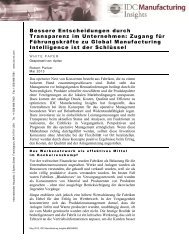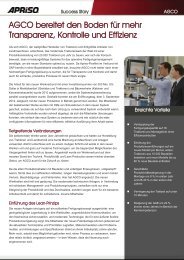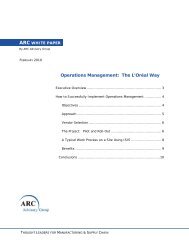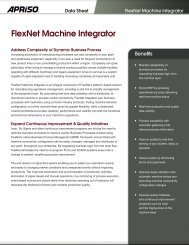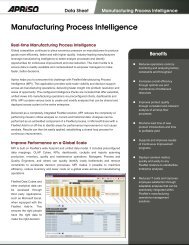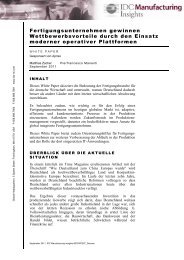Collaboration - Apriso
Collaboration - Apriso
Collaboration - Apriso
You also want an ePaper? Increase the reach of your titles
YUMPU automatically turns print PDFs into web optimized ePapers that Google loves.
6<br />
These strategies may involve new technologies, structures, partnerships, and commercial conditions.<br />
To be successful, it is necessary to work as part of a network and collaborate across all disciplines both<br />
in-house and with partners. Engineering, sourcing, procurement, supply chain, production, sales,<br />
marketing, distribution and service must share information and expertise. Good collaboration creates<br />
value because it allows the speed, flexibility, and holistic view of small decision-making units combined<br />
with the quality and efficiency of a connected network.<br />
Collaborate to co-ordinate<br />
Imagine a supply chain incident – a supplier mixed up deliveries between two sites. Moving<br />
materials between sites will take 48 hours, but they are needed for a customer order scheduled<br />
for production tomorrow. Is it possible to fulfil the order and maintain workloads at both sites?<br />
ERP scheduling shows a solution – but it involves delay to other orders, and planners need more<br />
information. Does the ERP materials information match reality? How critical are the orders<br />
according to sales? What is the impact of paying premium prices for materials from an<br />
alternative supplier today?<br />
Planners would use a collaborative environment to: review real inventory and shop-floor status;<br />
discuss priorities with sales and customers; negotiate with suppliers; and quickly implement a<br />
new optimal plan.<br />
Collaborate to sell<br />
Imagine the situation: a sales rep calls the office to report a meeting with a portable machinery<br />
manufacturer. “They love our technology, but they’ve rejected our offer because they want to<br />
use their existing supplier’s power management systems and get an integrated unit. We could<br />
do that, but it needs engineering. What shall we do?”<br />
Leading companies recognise that the way to win orders is to work with customers and,<br />
potentially, customers’ suppliers. This requires collaboration involving design, procurement,<br />
manufacturing, distribution and sales – in-house and throughout the supply chain.<br />
Collaborate to innovate<br />
In the old design office, team leaders, the chief engineer and office manager could walk around<br />
the room, get an impression of progress, discuss ideas, and explain new concepts.<br />
Early CAD systems offered productivity, quality, re-use and standardisation benefits, but small<br />
screen sizes and controlled environments worked against ad-hoc communication and big<br />
picture collaboration.<br />
Now, collaborative CAD environments can create the equivalent of a meeting around the<br />
drawing board – bringing together, say, electronic designers in Asia, functional designers and<br />
ergonomics specialists in Europe, and engineers representing contract manufacturers.<br />
Conditions to trigger innovation remain hard to define, but collaborative multi-disciplinary<br />
communication is a great start. A continuous stream of incremental innovations can be as<br />
valuable as a single big new concept.<br />
LEADING EDGE COLL ABORATIVE ENVIRONMENTS IN DISCRETE MANUFACTURING INDUSTRIES




